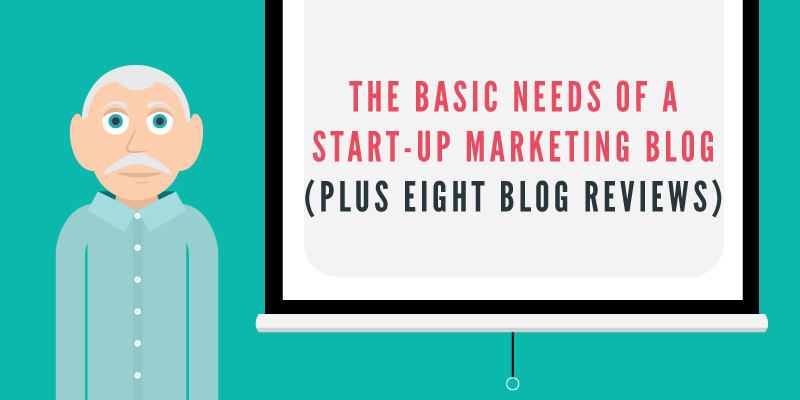We’ve worked with a myriad of clients to create blogs and social media strategies that help them market their business. We’re able to transcend the gap between industries because we understand all the components for a startup marketing blog. After all, we’ve been through the process many times.
Today, we’re going to take a look at the components that a startup marketing blog should have. We’re also going to take a look at a few startup blogs.
Your basic needs, if your startup has a blog
A major question to answer before launching your startup marketing blog is “What audience will you be writing for?”
One client of ours felt their blog was best targeted toward small business owners wanting to market their business. Another client felt their audience was the do-it-yourself investor looking for information. In both instances, these clients were using their blogs to market their brand, products, and expertise. Subtly.
Depending on what kind of startup you are, you may also go in this direction. For example, we blog for a living, so we blog about content marketing. It makes sense for us, as we get to constantly share our experience and insight on the world of blog marketing – what we see work, what doesn’t work, and all the advances that take place.
If your startup is related to anything that helps a business make more money, then you can focus your blog on marketing. For example, if you’re a payment processing technology for small businesses (like Stripe, or Swipely), you can blog about how to market your small business, because that’s something small business owners look for on the web. If you’re a CRM company (Like Blitz), you can blog about sales advice, because people who use customer relationship management software search for sales advice online.
OK, let’s assume you’ve already determined your audience and the premise of your blog. Here are eight components that a good startup marketing blog must have:
 1. Mission statement: Your target audience will want to learn about your brand and what you stand for. As a startup, it’s important to share this information up front. You may even come up with a cool blog title, like Eat24’s Bacon Sriracha Unicorn Diaries or Patagonia’s The Cleanest Line, or Beutler Ink’s The Ink Tank.
1. Mission statement: Your target audience will want to learn about your brand and what you stand for. As a startup, it’s important to share this information up front. You may even come up with a cool blog title, like Eat24’s Bacon Sriracha Unicorn Diaries or Patagonia’s The Cleanest Line, or Beutler Ink’s The Ink Tank.
2. Launch your startup marketing blog with content: Once your startup launches, there will be consistent opportunities for press. If you have new audience members and people from the media visiting your website for the first time, you’ll need there to be content on it. If there isn’t sufficient content when you launch, visitors may not end up coming back. Put your best foot forward by having content on your blog before launching.
3. Utilize search engine optimization: If you want to start generating a steady amount of organic website traffic, you’ll need to have a grasp on SEO. If you don’t understand the value of organic SEO or how to organically optimize your content, then you can either learn how to do it or hire someone to do it for you.
4. Find your voice: The voice of your blog is important. You want a tone that stays consistent, even if you have multiple writers. Each writer will likely have his or her own voice, but the brand’s voice must speak louder and clearer than all the rest.
5. Aesthetics are important: How many times have you visited websites that were so atrocious that you never went back? Focus on having a clearly designed blog that utilizes some imagery. Eliminating clutter and including an eye-catching design will help your blog take off.
6. Contact information: Contact information is important for all blogs and websites, and especially important for startup blogs because you’re new to the scene and people will be the most inclined to get in contact with startups. What if someone wants to buy a product or donate to a funding campaign? Or they want to send an email or phone call for business development purposes. At the very least, make sure there’s a call to action that leads to a contact form that can be filled out.
7. Email capture opportunities: How do you plan on building an audience? If you’re planning on using email marketing as part of your digital strategy, you should utilize email capture components on your website. This could include pop-ups that appear once a person (who isn’t a cookied user) lands on your website. This could also be a simple insert bar located on your left or right nav, calling people to act on signing up for your email list. If you need something simple and effective, we love HelloBar.
Side note: Building an email list is hugely important because it’s your way to keep in contact with your audience. You can send daily, weekly, or monthly email newsletters with upsells to aligned products or services. Email marketing will be not only a revenue stream, but also a promotional guide to keep you on top of mind with your audience. Inserting email capture elements on your website, and calling people to act on subscribing, is your best bet of developing a devout audience. People don’t always just arrive and buy (in fact they rarely do), so capturing their email address gives them a chance to get to know you.
8. Social interaction capabilities: Facebook has over a billion subscribers. Twitter is the ultimate micropublishing site that’s faster than actual news outlets. Pinterest has grown at an amazing rate. Including social media icons that link to your social accounts on all of your blog posts is how you get people to share your content on social networks. Throw in calls to action in your posts that suggest people share your content. It’s a great way to build an even larger audience while attracting new eyes to your content.
8 startup blogs and some suggestions
As promised, here’s a look at five startups and the blogs they produce (or the lack of a blog). For those without a blog, we supply some ideas on what could be written about in their theoretical blog.
A blog review: Oatbox
This breakfast club startup lets subscribers choose between mixes of oats. Each month a new mix of oats is curated and sent to subscribers. They have a beatifully formatted articled entitled “What’s Being Healthy?” The article has a story and great imagery.
However, this is the only article from the company. It would be great to see more blog content, sharing more depth about the oats they provide, recipes, and other oat-centric articles. Be the source on oats!
A blog review: GrubMarket
According to its website, “GrubMarket is an easy-to-use online farmer’s market offering fresh, high quality food from local vendors.”
Unfortunately, this digital business is still marketing like the traditional grocery store. Most of the posts titled like sales flyers, titled “this week’s pick” — meant to sell the product of the week. We can actually get behind the weekly pick posts because they’re fairly informative (a post on figs and goat cheese talks about how to keep figs fresh, and how to eat goat cheese.) A great way to sell a product.
However, those posts are images—even the text is part of one big image. Ouch.
That means nobody’s finding these posts in search because Google can’t read them. And that means all their blogging efforts are really for the people who already know them—not for new people who could be finding them through search.
Thankfully, every once in a while they post some text-based articles like recipes, along with tactical articles, like Opening a Store On GrubMarket in 4 Easy Steps. We’d like to see a lot more recipes to divvy up the salesy image-based featured product posts. And for them to start using real text in their promotional posts.
A blog review: Freight Farms
This startup is helping bring sustainable farming and food systems to more people in any type of environment. The company does have a blog, which has company info and info on their community, like Urban Cropland: Why More Cities are Growing their Own Food. I’d love to see more evergreen content added to this blog in the future, particularly content relevant to the farmer who may invest in these systems.
A blog review: Nomad House
I love the concept of Nomad House. According to its website, Nomad House is a “network of houses around the world for nomads to live and work together.”
Although the site has an attractive design, they have no blog. I wanted to include it in this list, because there are so many great ways to blog for a company like this. I would like to know about this company and the residents of these houses.
Interesting people often have interesting stories to tell, and I bet that would work well for a Nomad House blog, not to mention travel tips and stories for each of their Nomad House locations.
A blog review: Buffer Social
The power of social is deep and Buffer Social is connecting with that power. The company’s blog is great: It’s updated often and the content is valuable to anyone using social to market products and services.
Beyond writing informative content that’s relevant to their users, their blog homepage is loaded in calls to action. With this design, Buffer is basically saying: Think this content is free? Sure, well, it is. But we really, really, really want you to sign up for buffer.
A blog review: Bohemian Guitars
The Bohemian Blog shares the company’s “most recent rambling”, along with other great product videos, pictures, articles, and playlists associated with the company’s oil can guitars, basses, and ukeleles. The blog is very comprehensive — with 14 categories of content, ranging from “Bands” and “Bohos Backstage” to “Interviews” and “Festivals”. They have a series of playlists, like The Road Trip Playlist, plus other evergreen content, like The History of Rock n Roll.
A blog review: Drift Away Coffee
If you like coffee, this startup is worth knowing. And of course, their blog is pretty great, too. The Drift Away relationship begins with tasting the coffee kit, then favorites are picked, and coffees that will fit the favorite description will be sent to you.
The company blog, called CoffeeAcademy, is very aesthetically pleasing, with three large, high-resolution images on each row, marking a blog post with title underneath it. The blog titles themselves are intriguing too. A few examples: “Why is Coffee Called a Cup of Joe?” and “How to Remove Coffee Stains: Synthetic and Cotton Fabrics.” Somebody’s doing their SEO homework.
A blog review: Interior Define
This company has been referred to as the Warby Parker of interior design. The company’s process involves “Strong partnerships and close attention to detail,” so the consumer can get the luxurious furniture desired.
The company’s blog is as sleek as their products, featuring bright photography that pops off the blog page. The Journal includes commentary from designers, and the individual posts are easy to share with social media icons built right in.
Plus, they link to their products in every post. Yay! They barely even need traditional calls to action, because posts are written with links to shop pages. But one big at the bottom, even just for their email newsletter, couldn’t hurt.
If we had to suggest anything else, it would be to tackle some evergreen topics for SEO — there’s an abundance of interior design questions being asked online that Interior Define could answer to attract the right types of customers.
Are you creating a startup marketing blog, or are you a startup with a great marketing blog already? We’d love to hear from you!



















